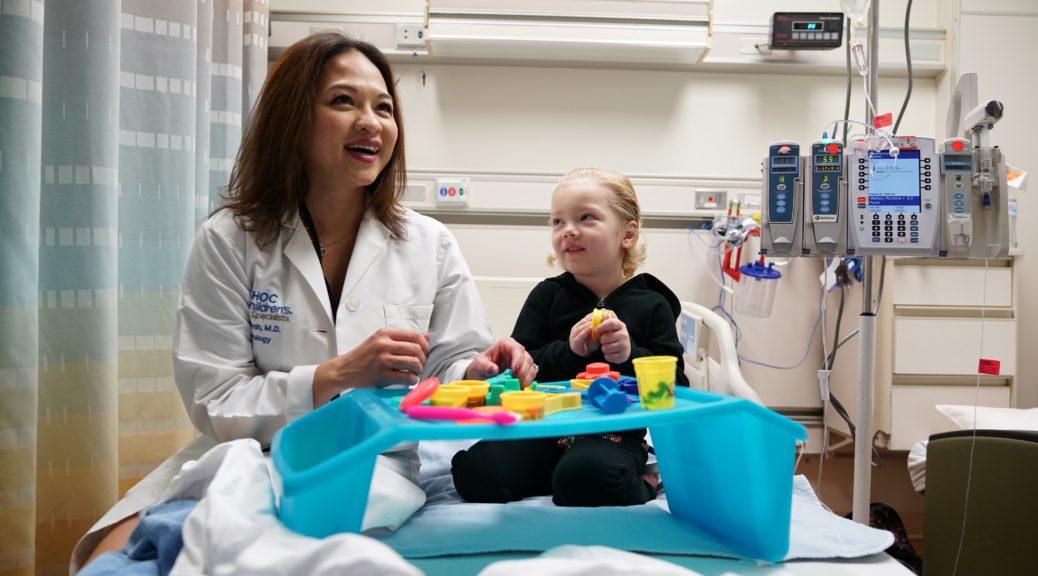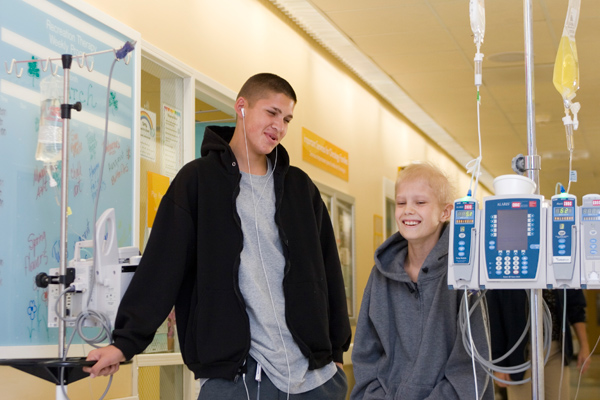Acute Lymphoblastic Leukemia (ALL)
The Leukemia Treatment Program at the Hyundai Cancer Institute at CHOC is dedicated to providing patients diagnosed with acute lymphoblastic leukemia with education, support and the most advanced, pediatric leukemia treatment available.

What is acute lymphoblastic leukemia?
Acute lymphoblastic leukemia (ALL), also referred to as acute lymphocytic leukemia, is the most common type of childhood cancer. ALL is a cancer that affects the bone marrow and white blood cells (WBC). The bone marrow produces different types of blood cells, including lymphocytes. Lymphocytes are a type of WBC that protects us from infection. In ALL, the lymphocytes undergo changes that make them grow out of control and take over the bone marrow.
These rapidly created immature white blood cells, or leukemia cells, do not function properly to fight infection and also prevent the bone marrow’s ability to create healthy blood cells. ALL can affect any type of lymphocyte cell. Lymphocytes consist of 2 main types, B-cells and T-cells. Their immature forms are the source of the two corresponding subsets of ALL, T-ALL and B-ALL.
What causes acute lymphoblastic leukemia?
We do not know the causes of ALL and there is no known way to prevent it in children. ALL can get worse quickly without treatment. However, with treatment, it is the childhood cancer with one of the best cure rates.
Symptoms and Signs of Acute Lymphoblastic Leukemia
The various ALL symptoms include:
- Fever, which can be a sign of infection
- Weakness or fatigue
- Pale skin
- Swollen lymph nodes
- Shortness of breath
- Chronic infections
- Night sweats
- Easy bruising or bleeding symptoms
- Bone and joint pain
- Abdominal pain
- Loss of appetite and weight loss
- Headaches or problems with vision and balance
Please consult your doctor if your child is experiencing these symptoms.
How is ALL diagnosed in children?
To diagnose ALL, the doctor will obtain a complete medical history and physical exam. Then, your child may undergo the following diagnostic tests:
- Complete blood count (CBC) tests: The CBC can show if there are too many or not enough white blood cells, or too few red blood cells and platelets. It can also reveal if there are immature lymphoblasts, or leukemia cells, in the blood.
- Bone marrow aspiration and biopsy: This involves inserting a needle into the pelvic bone to obtain a few teaspoons of bone marrow sample. Then, the sample is sent to the lab to be tested for leukemia cells. The bone marrow aspirate and biopsy is done using pain medicine, so it requires sedation or general anesthesia.
- Lumbar puncture (spinal tap): ALL can spread to the central nervous system. To identify if it has spread, doctors will perform a lumbar puncture. They can remove a sample of spinal fluid for testing by inserting a needle in the area of the lower spine. At the same time, medicines to prevent or treat leukemia in the brain or spinal cord can also be given through this needle. Pain medicine is also given when the lumbar puncture is
- Chest x-ray: X-rays of the chest is performed to see if the ALL has spread into the chest.
Acute Lymphoblastic Leukemia Treatments
The treatments for ALL depends on several factors that include:
- The subset of ALL (whether it is B-cell or T-cell)
- Age of your child
- The white blood cell count at diagnosis
- Features of the leukemia cells, such as chromosomes changes
- Your child’s overall health
How long are the treatments for ALL?
Treatment usually lasts about 2-3 years, with the first few months being the most intense. The treatment for ALL is conducted in several phases that include: induction, consolidation and maintenance.
- The first month of treatment is called induction. The goal of induction is to kill the leukemia cells and get the leukemia into remission. Remission is where leukemia cells are no longer found in the bone marrow or blood.
- The next 6-8 months occurs when the leukemia is in remission. The goal of consolidation is to kill any leukemia cells remaining in the body, limiting the chance for a relapse.
- Maintenance is the final phase with the goal to kill any remaining cells that can regrow. In this phase, the treatment is usually given in lower doses than the other 2 phases.
What are the treatments for ALL?
- Chemotherapy is the main treatment used for children with ALL and involves the use of a combination of drugs to kill ALL by targeting the fast-growing cancer cells.
- Targeted therapy uses drugs to identify and destroy specific leukemia. It is often used in conjunction with chemotherapy.
- Radiation therapy uses high-energy radiation like x-rays to target and kill cancer cells or stop cancer cell growth. It is rarely used to treat leukemia in the central nervous system or other places such as the testes.
- Bone marrow or stem cell transplant is conducted to provide healthy cells to a patient after they complete chemo or radiation treatment. It involves the infusion of healthy donor stem cells through an intravenous line to produce normal blood-forming cells. Bone marrow or stem cell transplantation is commonly used to treat ALL that has not responded to chemotherapy or that has a very high risk of relapse.
- Clinical trials, including immunotherapies, are research studies that provide the latest treatments to patients who are not responding to traditional treatments.
Doctors will evaluate your child’s age and overall health, likelihood of success and possible side effects before deciding the best treatments for your child.
Pediatric Leukemia Treatment Program

The Pediatric Leukemia Treatment Program at the Hyundai Cancer Institute at CHOC are experts who provide patients with the most comprehensive and advanced treatments. We specialize in treating all types of leukemia. Our team includes experienced leaders whose goal is to improve the care and cure rates for children and adolescent and young people with leukemia. We also work with patients receiving CAR T-Cell therapy and bone marrow transplants through the Hyundai Cancer Institute’s cellular therapy and Blood and Marrow Transplant Program.
Learn more about our services and treatments in our Pediatric Leukemia Treatment Program.












